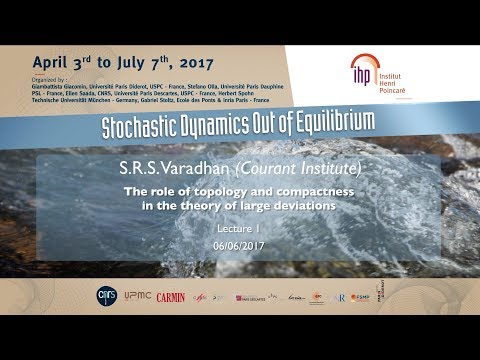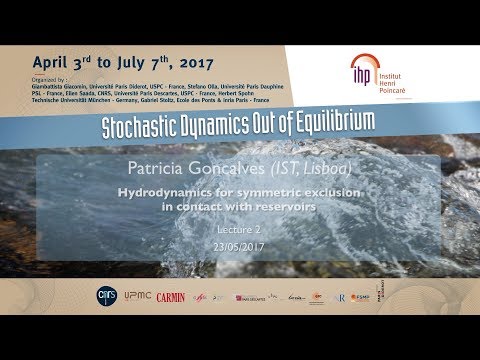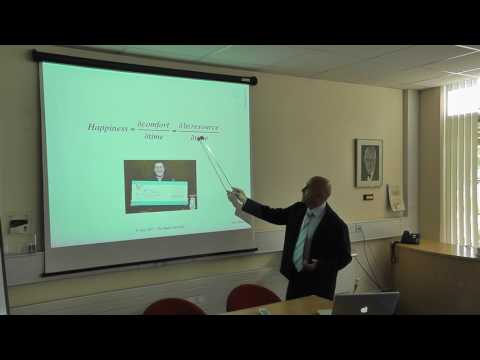source:
Institut Henri Poincaré

1:40:35
Balanced chemical reaction networks (...) - CEB T2 2017 - Desvillettes - 1/3 Laurent Desvillettes (Univ. Paris Diderot) - 26/06/17
Balanced chemical reaction networks and reaction-diffusion systems
Chemical reaction networks appear in many industrial devices and natural pr...

1:09:14
Structured Regularization Summer School - C. Boyer - 22/06/2017 Claire Boyer (UPMC) Towards realistic compressed sensing
Abstract: First, we will theoretically justify the applicability of compressed sensing (CS) in real-life applications. To do so, CS theore...

1:23:30
Structured Regularization Summer School - L. Rosasco - 4/4 - 22/06/2017 Lorenzo Rosasco (Genova and MIT): Regularization Methods for Large Scale Machine Learning
Abstract: Regularization techniques originally developed to solve linear inverse problems can be extended...

1:38:19
Structured Regularization Summer School - L. Rosasco - 3/4 - 22/06/2017 Lorenzo Rosasco (Genova and MIT): Regularization Methods for Large Scale Machine Learning
Abstract: Regularization techniques originally developed to solve linear inverse problems can be extended...

1:29:45
Structured Regularization Summer School - A. Montanari - 4/4 - 22/06/2017 Andrea Montanari (Stanford): Matrix and graph estimation
Abstract: Many statistics and unsupervised learning problems can be formalized as estimating a structured matrix or a graph from noisy or ...

1:29:38
Structured Regularization Summer School - L. Rosasco - 2/4 - 21/06/2017 Lorenzo Rosasco (Genova and MIT): Regularization Methods for Large Scale Machine Learning
Abstract: Regularization techniques originally developed to solve linear inverse problems can be extended...

1:36:27
Structured Regularization Summer School - L. Rosasco - 1/4 - 21/06/2017 Lorenzo Rosasco (Genova and MIT): Regularization Methods for Large Scale Machine Learning
Abstract: Regularization techniques originally developed to solve linear inverse problems can be extended...

1:07:15
Structured Regularization Summer School - É. Chouzenoux - 21/06/2017 Emilie Chouzenoux (Paris-Est): Majorization-Minimization Subspace Algorithms for Large Scale Data Processing
Abstract: Recent developments in data processing drive the need for solving optimization...

1:10:24
Bourbaki - 17/06/2017 - 4/4 - Nicolas BERGERON Variétés en expansion
[d'après Gromov, Guth, ...]
Vous pouvez nous rejoindre sur les réseaux sociaux pour suivre nos actualités.
Facebook :
https://www.facebook...

1:01:37
Structured Regularization Summer School - C. Fernandez-Granda - 20/06/2017 Carlos Fernandez-Granda (NYU): A sampling theorem for robust deconvolution
Abstract: In the 70s and 80s geophysicists proposed using l1-norm regularization for deconvolution problem in the context...

1:32:20
Structured Regularization Summer School - A. Montanari - 3/4 - 21/06/2017 Andrea Montanari (Stanford): Matrix and graph estimation
Abstract: Many statistics and unsupervised learning problems can be formalized as estimating a structured matrix or a graph from noisy or ...

1:27:14
Structured Regularization Summer School - A. Montanari - 2/4 - 20/06/2017 Andrea Montanari (Stanford): Matrix and graph estimation
Abstract: Many statistics and unsupervised learning problems can be formalized as estimating a structured matrix or a graph from noisy or ...

1:24:26
Structured Regularization Summer School - A.Hansen - 4/4 - 20/06/2017 Anders Hansen (Cambridge)
Lectures 1 and 2: Compressed Sensing: Structure and Imaging
Abstract: The above heading is the title of a new book to be published by Cambridge University Press. In the...

1:31:14
Structured Regularization Summer School - A.Hansen - 3/4 - 20/06/2017 Anders Hansen (Cambridge)
Lectures 1 and 2: Compressed Sensing: Structure and Imaging
Abstract: The above heading is the title of a new book to be published by Cambridge University Press. In the...

1:04:15
Structured Regularization Summer School - F. Bach - 19/06/2017 Francis Bach (INRIA): Submodular Functions: from Discrete to Continuous Domains
Abstract: Submodular set-functions have many applications in combinatorial optimization, as they can be minimized a...

1:34:23
Structured Regularization Summer School - A. Montanari - 1/4 - 19/06/2017 Andrea Montanari (Stanford): Matrix and graph estimation
Abstract: Many statistics and unsupervised learning problems can be formalized as estimating a structured matrix or a graph from noisy or ...

1:27:40
Structured Regularization Summer School - A.Hansen - 2/4 - 19/06/2017 Anders Hansen (Cambridge)
Lectures 1 and 2: Compressed Sensing: Structure and Imaging
Abstract: The above heading is the title of a new book to be published by Cambridge University Press. In the...

1:34:46
Structured Regularization Summer School - A.Hansen - 1/4 - 19/06/2017 Anders Hansen (Cambridge)
Lectures 1 and 2: Compressed Sensing: Structure and Imaging
Abstract: The above heading is the title of a new book to be published by Cambridge University Press. In the...

1:15:58
Bourbaki - 17/06/2017 - 1/4 - Joseph OESTERLÉ Densité maximale des empilements de sphères en dimensions 8 et 24
[d'après M. Viazovska et al.] Vous pouvez nous rejoindre sur les réseaux sociaux pour suivre no...

57:57
Bourbaki - 17/06/2017 - 3/4 - Frédéric ROUSSET Solutions faibles de l'équation de Navier-Stokes des fluides compressibles
[d'après A. Vasseur et C. Yu]
Vous pouvez nous rejoindre sur les réseaux sociaux pour ...

1:16:54
Bourbaki - 17/06/2017 - 2/4 - Lillian PIERCE The Vinogradov Mean Value Theorem
[after Bourgain, Demeter and Guth, and Wooley]
Vous pouvez nous rejoindre sur les réseaux sociaux pour suivre nos actualités....

1:02:14
Univers Convergents 2017 - Séance 5/6 - La vie privée de Sherlock Holmes La vie privée de Sherlock Holmes de Billy Wilder (USA / UK - 1970 - 2h05) avec Robert Stephens, Colin Blakely et Geneviève Page
Séance du 30 mai 2017
Un débat en présence de :
Jean-Pierre Crause...

1:09:09
Probabilités, Irréversibilité et Propagation du chaos - CEB T2 2017 - I.Gallagher - Public Lecture 3 Public lecture by Isabelle Gallagher (Université Paris Diderot), 14/06/17
Probabilités, Irréversibilité et Propagation du chaos
Suivant l'échelle à laquelle on observe un objet physique, on peut e...

14:33
L’Institut Henri Poincaré s’agrandit en 2020 ! Venez découvrir le chapitre 1 du documentaire « la Maison des mathématiques » qui réunira en un même lieu recherche mathématique au plus haut niveau, pédagogies innovantes et technologies de pointe...

1:23:08
The role of topology and compactness (...) - CEB T2 2017 - Varadhan - 2/3 S.R.S. Varadhan (Courant Institute) - 07/06/2017
The role of topology and compactness in the theory of large deviations
When a large deviation result is proved there is some topology involved in t...

1:32:19
CEB T2 2017 - Fraydoun Rezakhanlou - 2/3 Fraydoun Rezakhanlou (Berkeley) - 07/06/2017
The lectures will discuss the following topics:
1. Scalar Conservation Laws and theirs Markovian solutions
2. Conservation laws with stochastic exter...

1:22:18
The role of topology and compactness (...) - CEB T2 2017 - Varadhan - 1/3 S.R.S. Varadhan (Courant Institute) - 06/06/2017
The role of topology and compactness in the theory of large deviations
When a large deviation result is proved there is some topology involved in t...

1:32:24
CEB T2 2017 - Fraydoun Rezakhanlou - 1/3 Fraydoun Rezakhanlou (Berkeley) - 06/06/2017
The lectures will discuss the following topics:
1. Scalar Conservation Laws and theirs Markovian solutions
2. Conservation laws with stochastic exter...

15:18
Esthétopies - Variétés d'espaces sensibles Esthétopies
Variétés d'espaces sensibles
http://esthetopies.ihp.fr
Une exposition de Pierre Berger,
avec Pierre-Yves Fave, Sergio Krakowski, Vincent Martial et Jimena Royo-Letelier
Une performanc...

1:41:44
The appearance of noise like behaviour (...) systems - CEB T2 2017 - Liverani - 3/3 Carlangelo Liverani (Univ. Roma Tor Vergata) - 31/05/17
The appearance of noise like behaviour in deterministic dynamical systems
I will discuss how noise can arise in deterministic systems with s...

1:34:48
The appearance of noise like behaviour (...) systems - CEB T2 2017 - Liverani - 2/3 Carlangelo Liverani (Univ. Roma Tor Vergata) - 30/05/17
The appearance of noise like behaviour in deterministic dynamical systems
I will discuss how noise can arise in deterministic systems with s...

1:35:18
The appearance of noise like behaviour (...) systems - CEB T2 2017 - Liverani - 1/3 Carlangelo Liverani (Univ. Roma Tor Vergata) - 29/05/17
The appearance of noise like behaviour in deterministic dynamical systems
I will discuss how noise can arise in deterministic systems with s...

1:30:57
Hydrodynamics for symmetric exclusion in contact with reservoirs. - CEB T2 2017 - Goncalves - 3/3 Patricia Goncalves (Instituto Superior Técnico, Lisboa) - 24/05/17
Hydrodynamics for symmetric exclusion in contact with reservoirs.
In the first lecture I will discuss the notion of hydrodynamic ...

1:28:01
Hydrodynamics for symmetric exclusion in contact with reservoirs. - CEB T2 2017 - Goncalves - 2/3 Patricia Goncalves (Instituto Superior Técnico, Lisboa) - 23/05/17
Hydrodynamics for symmetric exclusion in contact with reservoirs.
In the first lecture I will discuss the notion of hydrodynamic ...

1:26:17
Hydrodynamics for symmetric exclusion in contact with reservoirs. - CEB T2 2017 - Goncalves - 1/3 Patricia Goncalves (Instituto Superior Técnico, Lisboa)
Hydrodynamics for symmetric exclusion in contact with reservoirs.
In the first lecture I will discuss the notion of hydrodynamic limit and a...
 37:16 Hall & Rivero: Food Insecurity in Orange County a Public Health seminar presented by Christina Hall and Jerry Rivero
37:16 Hall & Rivero: Food Insecurity in Orange County a Public Health seminar presented by Christina Hall and Jerry Rivero 38:23 Franks: Parent Engagement in Building Healthy School Environments SEMINAR ABSTRACT
38:23 Franks: Parent Engagement in Building Healthy School Environments SEMINAR ABSTRACT 48:12 LeBron: Disrupting Restrictive ID Policies To Promote Health Equity A Public Health seminar presented by Alana M.W. LeBron
48:12 LeBron: Disrupting Restrictive ID Policies To Promote Health Equity A Public Health seminar presented by Alana M.W. LeBron 51:08 Health Disparities Research and Practice in a Changing Political Context Health Disparities Research and Practice in a Changing Political Context: Hosted by Health and Justice Advocates at UCI
51:08 Health Disparities Research and Practice in a Changing Political Context Health Disparities Research and Practice in a Changing Political Context: Hosted by Health and Justice Advocates at UCI 45:36 Goddard: Drivers' attitudes about bicyclists UC Irvine Public Health Seminar - recorded on May 8, 2017
45:36 Goddard: Drivers' attitudes about bicyclists UC Irvine Public Health Seminar - recorded on May 8, 2017 49:59 Michael Carson Persistence of the White Plague TB Persistence of the White Plague (Tuberculosis): An Infectious Disease Perspective of Public Health
49:59 Michael Carson Persistence of the White Plague TB Persistence of the White Plague (Tuberculosis): An Infectious Disease Perspective of Public Health










































